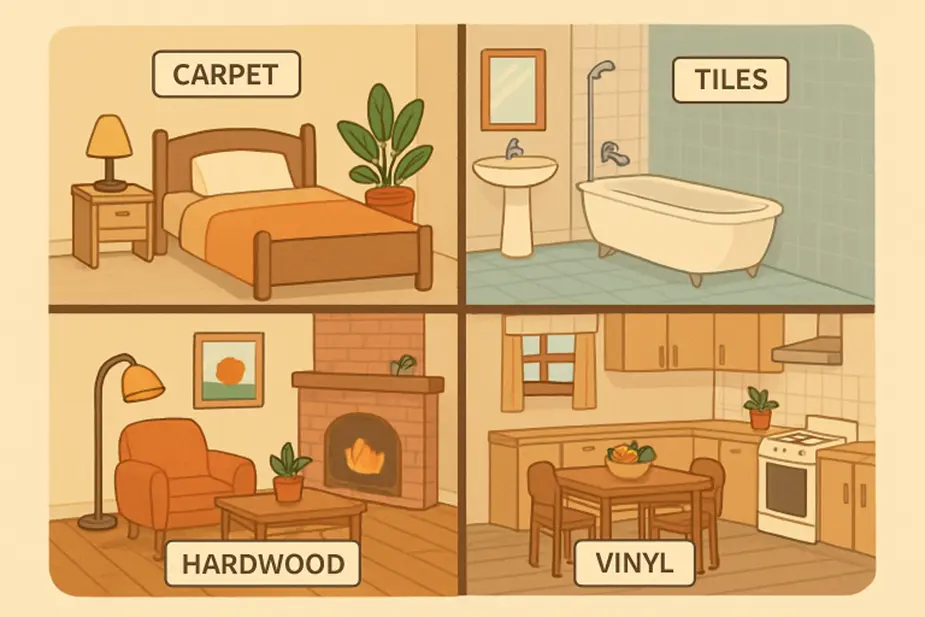Flooring and Indoor Comfort: The Basics
The flooring in your home impacts comfort and indoor environment. Carpet offers coziness and warmth, ideal for bedrooms, while tiles suit high-traffic areas with a cooling effect. Choice affects heating, cooling, air quality, and noise reduction.
Consulting with experts like Artisan Flooring of NC ensures homeowners select materials tailored to lifestyle, climate, and budget. These specialists understand that flooring impacts not just how beautiful a space looks, but also how comfortable and energy-efficient it will remain throughout the seasons. They can provide valuable guidance on maintenance and durability, helping homeowners make informed decisions. Additionally, their professional installation ensures the longevity and optimal performance of the flooring choices.
Energy Efficiency and Insulation Properties of Popular Flooring Types
Flooring has a direct impact on how well your house retains or disperses heat. Carpet serves as an effective thermal barrier, trapping warmth and insulating rooms during the winter months—a feature especially appreciated in bedrooms and living spaces. Hardwood, meanwhile, offers a classic look but without the same insulating value; however, it performs well in temperate climates and can be paired with insulating underlayment for improved efficiency. Laminate and vinyl have various insulation levels depending on thickness and underlayment, while tile and stone naturally stay cool, providing relief in hot climates but often requiring radiant heating systems in colder areas.
Innovative materials such as cork and some luxury vinyl plank flooring combine comfort, style, and surprising insulation capabilities. These choices offer eco-conscious homeowners both comfort and reduced energy expenses over time.
Room-by-Room Flooring Recommendations
- Bedrooms:Plush carpet or engineered wood are excellent for creating warmth, reducing noise, and providing a soft landing for tired feet.
- Kitchens & Bathrooms:Tile and waterproof vinyl are ideal due to their moisture resistance, ease of maintenance, and durability against spills and splashes.
- Living Areas:Engineered hardwood offers timeless appeal paired with durability, while laminate is a cost-effective alternative for high-traffic zones.
- Basements:Due to possible exposure to dampness, luxury vinyl planks or tiles are often the best choice, thanks to their water resistance and resilience.
Every space in your home serves a unique function and is subject to varying amounts of foot traffic, moisture, and temperature swings. Matching your flooring to the demands of individual rooms leads to longer-lasting comfort and optimal energy use.
Eco-Friendly Flooring: Greener Choices
The trend toward sustainable living has ushered in a variety of eco-friendly flooring options. Bamboo and cork are among the most popular materials due to their renewability and minimal environmental impact. Reclaimed hardwood salvages resources while adding rustic charm, and linoleum—made from linseed oil, cork dust, and wood flour—is biodegradable and surprisingly resilient. Choosing low-VOC finishes and adhesives can also improve indoor air quality. For a detailed analysis of sustainable flooring, visit Green Building Advisor.
The Role of Proper Installation
When it comes to flooring, expert installation is just as crucial as the material itself. Improperly installed flooring can leave gaps, permit drafts, or allow moisture intrusion—issues that greatly diminish both comfort and efficiency. Ensuring correct underlayment, moisture barriers, and professional craftsmanship prevents energy loss around the edges and maximizes the lifespan of your investment.
Qualified installers guarantee not only a visual match with your design goals but also the physical performance required in high-traffic or moisture-prone areas. This step is not one to overlook if you’re seeking lasting comfort and energy savings.
Maintaining Floors for Long-Term Energy Performance
Even the best flooring will perform poorly if ignored. Clean carpets routinely to prevent matting and preserve their insulating properties. Wood floors may need periodic resealing to protect against drafts and moisture. Tiles should be checked for cracks or grout damage to stop hidden air leaks. Regular maintenance optimizes the energy-saving potential of your floors and keeps your home fresh and inviting.
Adopting simple care habits, like using area rugs for added insulation or managing dampness in basements, further enhances efficiency and year-round comfort. For more on maintaining healthy, energy-efficient indoor spaces, Energy.gov provides a range of helpful tips on energy-efficient home choices.
Future Trends in Flooring and Home Energy
Flooring technology is advancing rapidly. Homeowners can now take advantage of engineered materials with built-in heating for cold climates, or surfaces made from high percentages of recycled content that close the loop on sustainability. Smart home integrations are also becoming a reality, with sensors embedded in flooring to monitor footfall, optimize heating, or even track air quality. The next generation of flooring promises to marry form, function, and intelligence for even greater energy efficiency and comfort.
These innovations reflect a broader shift toward homes that are environmentally responsible, cost-effective to operate, and appealing to live in for decades to come.
Conclusion
Flooring plays a far bigger role in your home’s comfort, energy efficiency, and day-to-day enjoyment than most realize. From initial selection and expert installation to continued maintenance, each step matters. By making informed choices and staying ahead of the latest innovations, you’ll enjoy a home that’s more comfortable, sustainable, and economical for years to come.
Also Read-
